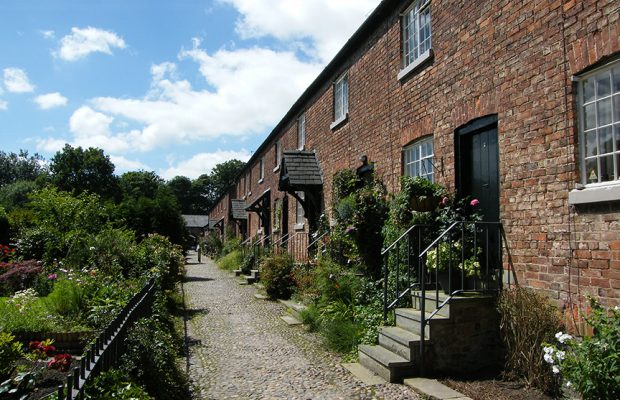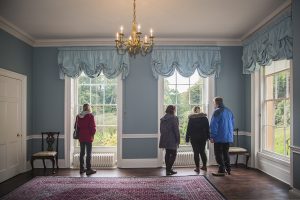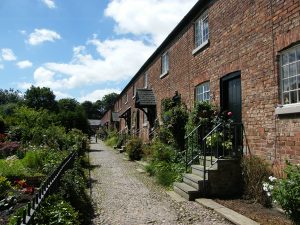- Home
- News
- What’s On
- Activities for Children
- Arts & Crafts
- Autos and Bikes
- Business events
- Car Boot & Auctions
- Charity events
- Churches & Religious
- Comedy
- Dance
- Days out & Local interest
- Education
- Exhibition
- Film
- Gardening & Horticulture
- Health
- Markets & Fairs
- Music
- Nature & Environment
- Spiritual
- Sport
- Talks and Discussions
- Theatre and Drama
- Business
- Local Information
- Jobs
- Deaths
- Charity events
- Contact Us
Side by side but worlds apart

Above: Exterior of Oak Cottages in Styal – the row includes the worker’s cottage
Side by side but worlds apart: new spaces at Quarry Bank tell the story of an industrial community
New spaces have opened at the National Trust’s Quarry Bank in Cheshire, adding to the picture of the industrial community that lived and worked there. Quarry Bank House, home to the cotton mill owning Greg family, delves into the intellectual, social and domestic life of Hannah Greg, wife of Quarry Bank’s founder Samuel. Just a short walk away in Styal village, the hardships of daily life for the Greg family’s workers are uncovered in a permanent exhibition in the village hub and a unique tour of a mill worker’s cottage.
Amanda Lunt, general manager at Quarry Bank, said, ‘Quarry Bank is, and always has been, much more than a mill. By restoring these houses, and exploring the domestic lives of both owner and worker, we’re able to engage our visitors with a different side of the story. We hope that visitors will be charmed and challenged by these new experiences.’
Piecing history together
Although the cotton mill, Apprentice House, Styal village and estate were gifted to the National Trust in 1939, it wasn’t until 2006 that the opportunity to acquire Quarry Bank House and part of the gardens presented itself. The house and gardens were a domestic idyll created by the Greg family in the early 19th century, providing them with a rural retreat from rapidly industrialising Manchester. This missing piece of the puzzle was crucial to the development of the ongoing Quarry Bank Project.
Amanda continued, ‘from the moment that the Trust acquired Quarry Bank House, we knew we had a unique opportunity. For the first time we had the chance to go beyond the working environment of the mill to tell the whole story of Quarry Bank. It’s been a long journey, and we’re not quite finished yet, but it’s a joy to be able to open the house to visitors and welcome them into Hannah Greg’s world.’
Hannah’s vision
Hannah created a sanctuary at Quarry Bank. A woman of education, she was concerned with the improvement of herself and her thirteen children through learning, debate, and the host of well-informed friends and acquaintances who were invited to Quarry Bank House. Today, visitors can explore the family home through Hannah’s experiences. Facsimiles of her writings are on display, and a team of staff and volunteers will engage visitors with stories of Hannah and her family.

Visitors admire the view out of the drawing room window in Quarry Bank House – ⓒ Nick King. Click on image to enlarge
An elegant, well-read home
To recreate the atmosphere of this genteel Georgian home, a dedicated team of conservation specialists, archivists, academics from the University of Manchester and volunteers set to work. Although the Gregs left a huge number of personal papers and letters, there’s almost no description of how they decorated their home, and none of their furniture is retained within Quarry Bank’s collection. The available evidence points to an elegant and tasteful style of living, with greater focus on intellectual pursuits than material ones. Contemporary visitors wrote of the ‘grave simplicity of the household, their intellectual ways, the absence of display, and even of knick-knacks, the pale blue walls, the unadorned furniture, the well-filled bookcases, the portrait of George Washington over the chimney piece…’
Katie Taylor, regional curator at the National Trust, said, ‘we had an unusual challenge with Quarry Bank House. With so little to go on for how the interior should look, we took inspiration from similar homes of the period. We used contemporary paintings to understand the colours and patterns that would have been used in the different rooms, and engaged a host of specialists to advise us on the look and feel of the soft furnishings.’
Wider community
In the village of Styal, just ten minutes’ walk from the mill, the Gregs built rows of terraced cottages for their workers. The community that expanded so dramatically during the early Industrial Revolution continues to thrive today. To tell the story of the village, a permanent exhibition that explores the lives of the mill workers has been created in the village hub. Inside a worker’s cottage, layers of history were unravelled through an extensive restoration process. Known locally as the ‘pickled cottage’, number 13 Oak Cottages has been left untouched since the 1970s and wasn’t modernised with the rest of the houses in Styal. It offers a unique window into the past.
Ally Tsilika, Archive and Collections Manager at Quarry Bank, said, ‘unlike the Greg family, the majority of workers’ lives have been preserved only in the records that were kept about them, such as censuses, wage and rent books. What we’re missing is people’s personalities, but you can get a tantalising glimpse of that inside the cottage. The worker’s cottage is one of the few ways that we still have to explore the lives of those whose thoughts, feelings and hopes are now lost to us.’
The fabric of life
During the conservation and restoration process, six layers of wallpaper were uncovered, tracing the tastes and decoration choices of the cottage’s tenants back through the generations. Much of the wallpaper was peeling from the wall when restoration work started, and has been painstakingly restored by a conservation specialist. The Quarry Bank team have also taken great care to look after the historic linoleum that covered the floor.
Ally continued, ‘it doesn’t sounds very glamorous, but the early twentieth century lino in the worker’s cottage is a treasure in the National Trust’s collection. Most lino of that period was used in working people’s homes, and has been thrown away as successive generations have redecorated and renovated, so it’s actually very rare. This is the history that doesn’t normally survive, and it’s our privilege to care for it.’
Tours of the worker’s cottage are limited to a maximum of eight people per tour due to the house’s small size. On the tour, visitors are encouraged to consider the how the home lives of Quarry Bank’s workers differed to their own. Up to 14 people would have lived in each two-up-two-down cottage, with the cellar beneath the house rented to a separate family altogether. Although living conditions in Styal were generally better than in the centre of Manchester at the time, they are surprising and at times shocking to modern eyes. Despite this, a community was built here that has lasted, and can now be enjoyed by Quarry Bank’s visitors.
The National Trust has been able to open these spaces thanks to funding from the Heritage Lottery Fund and Arts Council England. The £9.4million Quarry Bank Project, of which the opening of the two houses forms one part, aims to transform visitors’ experiences at Quarry Bank, and to present its stories and history in new and innovative ways.
For more details please visit: www.nationaltrust.org.uk/quarry-bank



You must be logged in to post a comment Login